It’s one thing to drive a new model for a few hours around town but something entirely different to head into the hard-baked backblocks and see how it copes with life off the blacktop. That’s exactly what we did with UD’s new 460hp Quon and it didn’t take long to confirm that Australia’s best Japanese heavy-duty truck is now even better. Heaps better!
It’s mid-morning on a brick-hard stretch of dirt an hour or so out of Charleville.
Already, the air is a furnace. That heavy, sapping heat, sucking moisture from every pore.
In the mirrors, bleached dust blooms into cauldron clouds and all around it seems nature has once again decreed a scorched earth summer for much of south-west Queensland.
Christmas is less than a fortnight away, and for many farming families in this part of the world, life remains fiercely tough. Few probably have greater understanding of just how tough than Brian Egan.
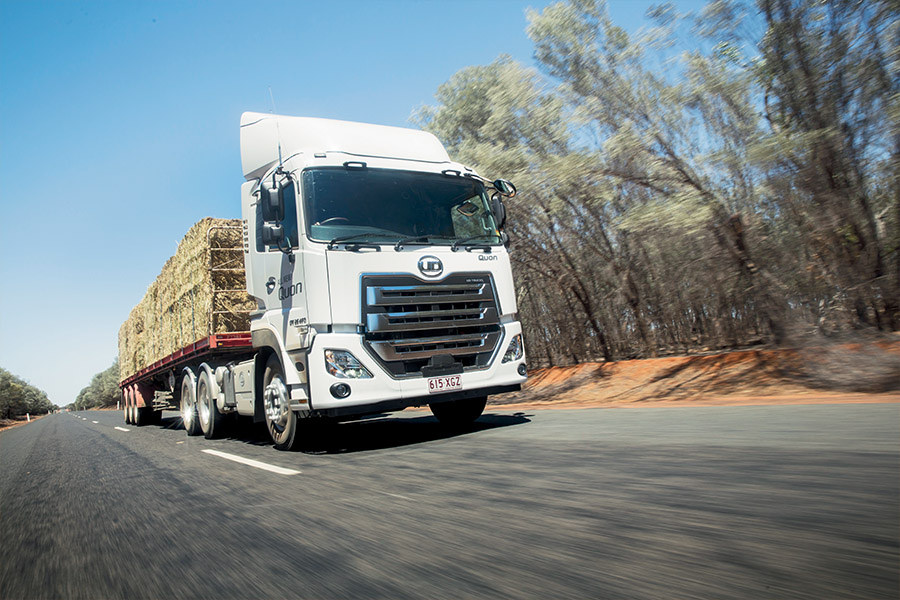 |
|
Quon handled blacktop and dirt with equal ease, though searing temperatures kept the engine fan busy on the bitumen
|
Co-founder of the Aussie Helpers Charity based in Charleville, Brian and wife Nerida have, for the past 15 years or so, dedicated themselves to alleviating at least some of the stress of a drought-stricken existence.
Or, more simply perhaps, just showing that someone cares when economic and emotional hardships rip at the fabric of remote families.
From bitter personal experience, the Egans know only too well just how demeaning and debilitating the hardship can be.
Whether it’s Christmas presents for kids, food hampers and everyday family necessities, or feed for livestock, Aussie Helpers relies on the goodwill and generosity of donations from companies and individuals around Australia to, as Brian puts it, “Just lend a hand.”
And so it was that over a couple of screaming hot December mornings, a new UD Quon hooked to a flat-top trailer could be found in Aussie Helpers’ Charleville depot being loaded with donated Victorian hay, bound for parched properties across a wide expanse of country.
Sure, in the big scheme of things, it’s probably not a big deal to take a new truck and deliver a couple of relatively modest loads of hay.
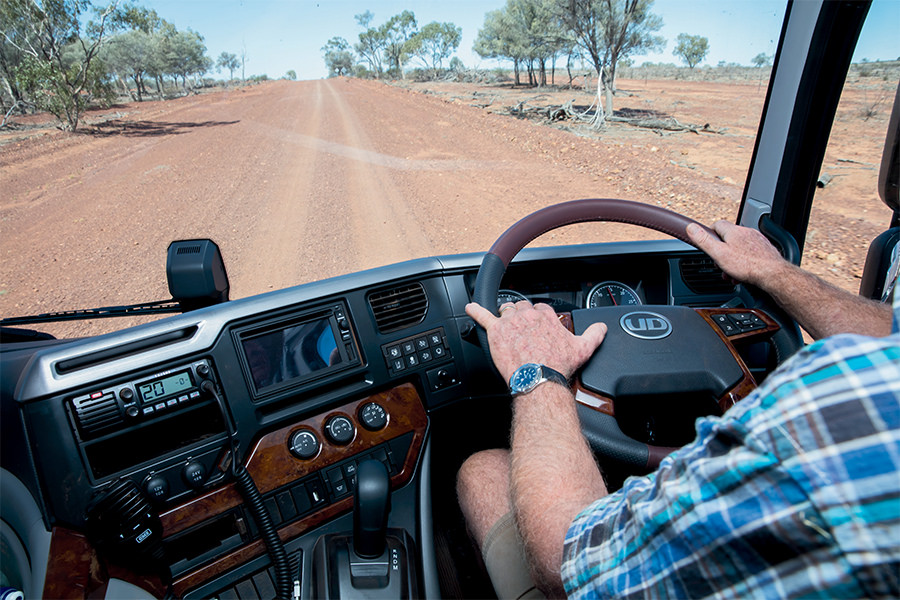 |
|
UD has travelled a long and sometimes lonely road in the Volvo conglomerate but evolution is now kicking in, big time! Quon is a class act
|
Still, we certainly couldn’t see any harm in at least contributing something to a worthy cause while, at the same time, determining if the new UD was as good in the dust and heat of the backblocks as it had certainly shown itself to be in earlier drives around the Brisbane ’burbs.
Besides, Brian Egan and his ‘clients’ are happy to take all the help they can get.
Anyway, it’s an exercise that simply grew from the wisp of an idea at the 2017 Brisbane Truck Show, where the reinvigorated Quon made its public debut.
With its striking new ‘face’, the new Quon’s appearance was, in effect, the next step in what UD senior executives were confidently predicting would be a significant increase in sales as the brand pursued a carefully constructed return to its heavy-duty roots.
Unlike its Japanese rivals, whose initial thrust into the Australian market was with light- and medium-duty trucks, UD (or Nissan Diesel as it was formerly known) was a heavy-duty specialist from the start.
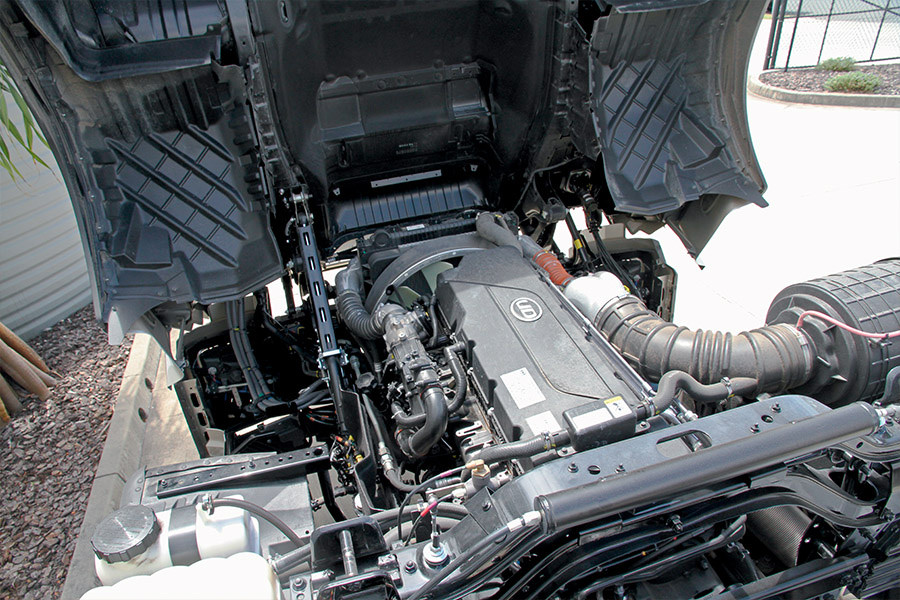 |
|
Lively! At 460hp and with more than 1600ft-lb of torque, GH11 is extremely responsive. As for a 13-litre version, it won’t happen
|
The product portfolio has long included medium-duty models, and that will certainly continue. But make no mistake, the heavy-duty market is the major focus for a revitalised UD.
The first step came in late 2016 with the launch of the Condor PW tandem-drive rigid model.
Together with its PD 6×2 sibling, the PW has pulled the brand at least some way out of the heavy-duty bog where, for more years than not, it has struggled to scratch barely 2 per cent of the market.
In fact, UD operatives are elated with the brand’s 2017 sales performance.
Along with 524 units sold into the medium-duty class, the brand notched its best year ever in heavy-duty sales with 3.3 per cent (393 units) of the sector, in the process finishing ahead of Fuso, DAF and Western Star.
For what it’s worth, it also beat Hino by a single unit, but, as for threatening the heavy-duty stake of Isuzu with its hugely successful six-wheeler and eight-wheeler models, that might be a bridge too far at this early stage of a UD resurgence.
Whatever, UD insiders are adamant the best is yet to come and, given early impressions of the new Quon, it’s easy to believe.
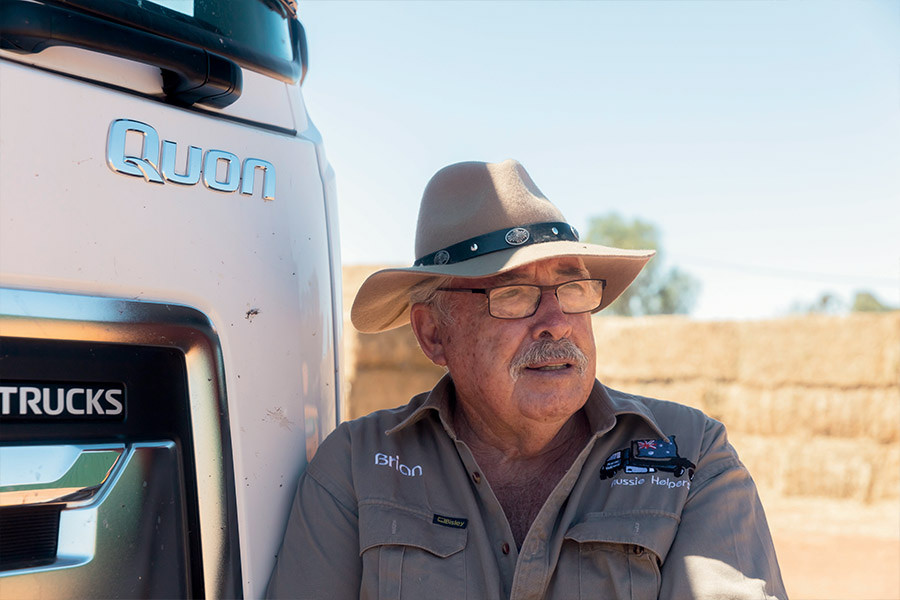 |
|
Aussie Helpers’ Brian Egan. Dedicated to simply lending a hand
|
While the PW showed from the outset it had the goods to win more business in the lighter end of the heavy-duty class, there was no escaping the fact that the flagship Quon was the model needing a substantial boost in both performance and overall appeal if the brand was to score the numbers needed for a sharp step up the sales charts.
Given the extent of competition, it won’t be easy but UD insiders aren’t short on optimism, eagerly declaring in the lead-up to the Brisbane Truck Show that the arrival of a fully revamped Quon would set an entirely new standard for a Japanese heavy-duty truck.
They weren’t exaggerating.
Even a cursory glance in and around the show truck left no doubt that, finally, a decade after UD actually became part of the Volvo conglomerate, the group assets of its corporate master have taken Quon to a substantially higher plane.
Sure, the absence of Volvo’s 13-litre engine remains a notable omission but, even so, this is a truck with the potential to turn UD’s heavy-duty aspirations into bold reality.
More to the point, a truck that not only further broadens the gap on its Japanese competitors in prime mover and truck and dog configurations, but, for the first time, provides a Japanese heavy-duty truck with the operational armoury and technical smarts to make it truly competitive with European models of similar output.
And therein, arguably, is a prime reason why Volvo Group principals have steadfastly refused to allow Quon to be fitted with the 13-litre engine so immensely popular in Volvo’s FM and FH models, and as the MP8 in Mack’s range.
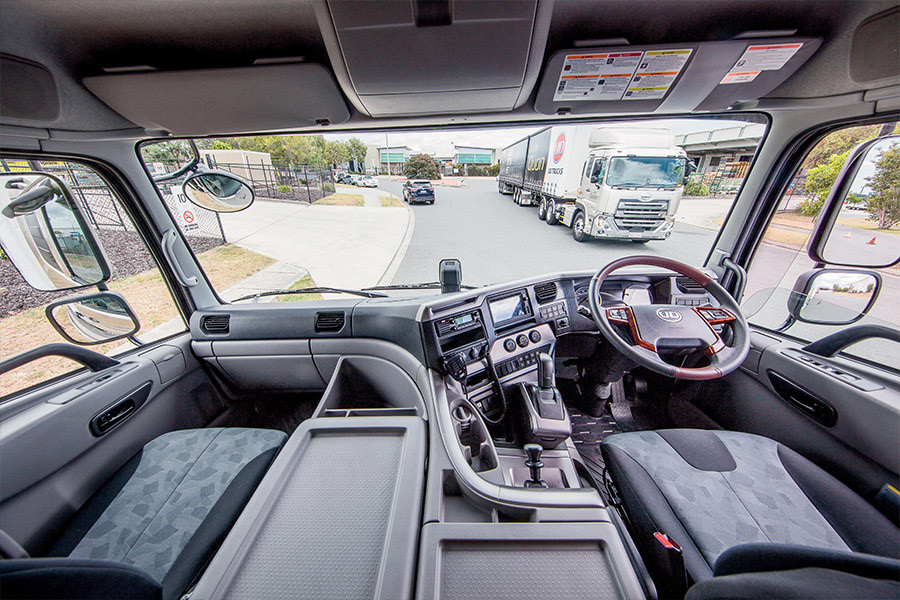 |
|
Wide view of a well-equipped Quon cab. Comfortable, practical and a touch of class
|
Viewed cynically, it’s easy to see how the continued absence of a 13-litre option gives rise to the opinion that UD is indeed the poor cousin of corporate kinsmen Mack and Volvo.
However, viewed from a more pragmatic angle, it’s not difficult to understand Volvo’s thinking.
Given the new Quon’s many features, a 13-litre version with up to 540hp would indeed be a formidable challenger to any Euro brand, including Volvo’s highly successful FM and, obviously enough, that’s the sort of internal contest corporate powerbrokers want to avoid at all cost.
As Volvo sees it, there are already enough competitors in the market without creating one of their own.
Consequently, there will be no 13-litre engine in Quon. Not now, nor any time in the foreseeable future. End of story. As UD senior executive Mark Strambi comments: “UD has a very clear focus on where it’s going in product terms.”
Even without a 13-litre engine, it’s a focus that now, more than ever, draws on Volvo Group technology across the board, from engine to transmission, axles, technology and safety.
What’s more, UD claims between 150 and 250kg have been trimmed out of the tare weight of various Quon models.
As for future developments, we hear that in, maybe, a year from now we’ll see an eight-wheeler derivative with a load-sharing twin-steer.
What we won’t see, however, is the addition of UD’s low-budget Quester model. According to Volvo Group Australia (VGA), Quester was designed primarily for Asia and that’s where it’ll largely stay, though VGA does sell the model into Papua New Guinea.
So, as things stand at the moment and probably for some years to come, the UD focus is squarely on Quon. Given the broad range of targeted applications, there’s nothing to suggest the new model misses out on anything, including more muscle.
MORE THAN BEFORE
Under the heavily revamped cab, for instance, is the same Volvo-designed, Japan-built GH11 10.8-litre engine that has served the previous Quon well at 390 and 420hp.
The big difference in this case is that the new model adds the lively and exceptionally responsive 460hp (309kW) version with peak torque of 1623ft-lb (2200Nm) on tap at 1200rpm.
Sure, it’s not 500hp, but as the top power rating in the range, the 460 certainly gives more than before.
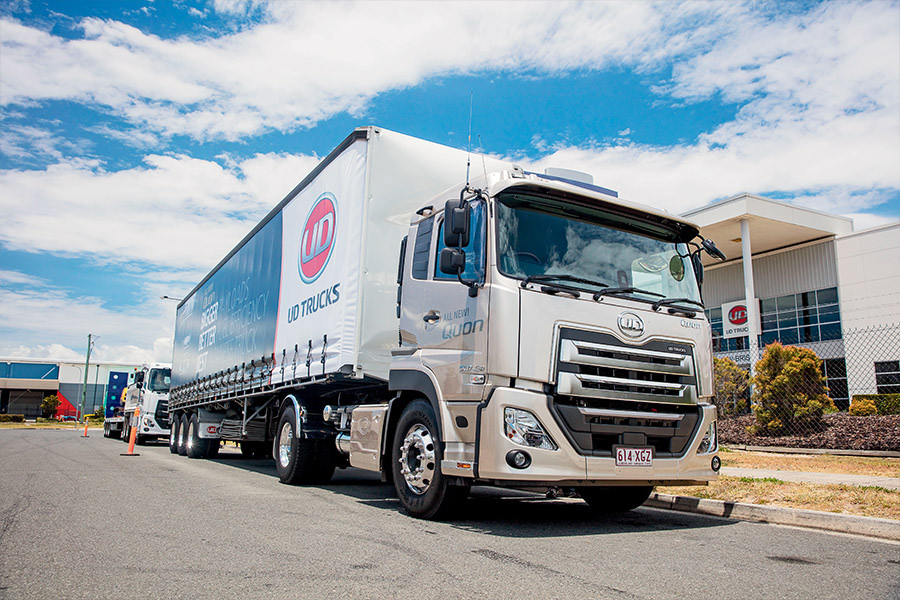 |
|
Life in the ‘burbs. Single-drive prime mover, truck and three-axle dog, and 6×2 rigid were particularly impressive in a day-long drive program around Brisbane
|
Meantime, both the 420hp version with 1401ft-lb (1900Nm) of torque and the 390hp (287kW) setting with 1290ft-lb (1750Nm) are retained in the new line-up.
Predictably, all three versions of the GH11 use an SCR emissions system to comply with Euro 6 emissions standards.
 |
As UD likes to point out, the first Quon was shown to the world at the 2004 Tokyo Motor Show and was the first truck model in the world to base emissions compliance on a strange and poorly understood technology called selective catalytic reduction, or SCR.
There were plenty of pundits who poo-poo’d (and yes, I was one) the idea of adding liquid urea (AdBlue) to a truck’s inventory but, as time and technology have subsequently shown, UD was bravely ahead of its time with its faith in SCR.
 |
Yet despite the hype of last year’s Brisbane Truck Show, UD certainly wasn’t prepared to rush its new flagship to market, spending most of 2017 fine-tuning specifications and ensuring that all the durability boxes had been ticked several times over.
Then, finally, with the year quickly drawing to a close, and confident it had the right products and plans in place, UD bit the bullet and assembled a wide range of configurations for a day of test drives around Brisbane.
IN THE ’BURBS
UD had done its homework well, supplying demo units configured as a six-wheeler body truck, truck and dog combinations, single- and tandem-drive prime movers pulling tri-axle trailers, and a B-double outfit – all loaded at or near full weight.
It surprised no one that all models have the GH11 engine coupled to the Escot-VI 12-speed automated transmission, which is, of course, UD’s version of Volvo’s super-successful I-Shift stirrer.
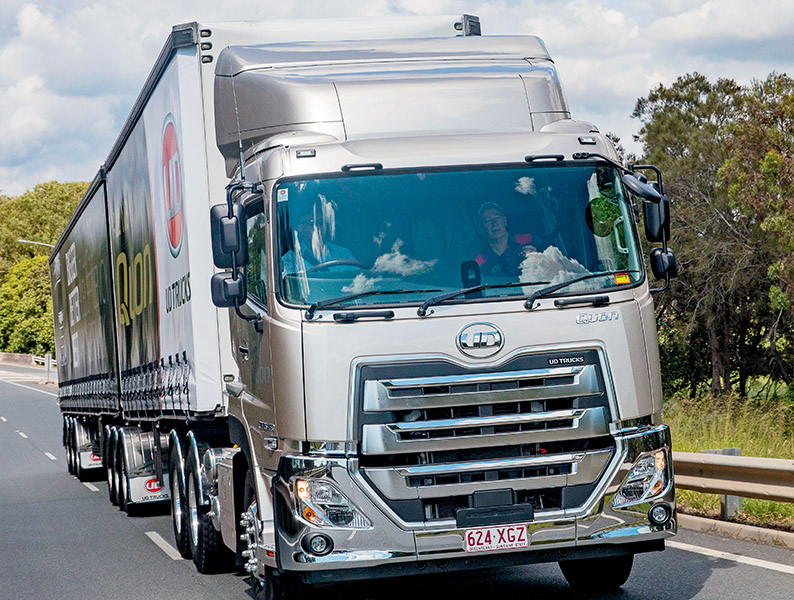 |
|
Line-haul B-double is definitely not on the Quon agenda but, for short-haul local work, a 460hp demo model coped surprisingly well with double duties
|
As expected, the harmony between engine and transmission is exceptional, controlled by the same shift lever assembly used in Volvo models and employing fuel-saving features such as ‘Escot Roll’ (sounds more like a trendy snail sandwich), which allows the truck to roll in neutral under the right conditions. Smart and very effective!
Also derived from Volvo is a comprehensive standard safety package across all models, which includes electronic disc brakes, a four-stage retarder, stability control system, lane departure warning, and hill-hold function.
There’s also the ‘traffic eye’ brake and cruise control system that uses radar and camera to monitor the area in front of the truck and, where necessary, either warn the driver they’re too close to the vehicle ahead or, in severe cases, apply the brakes to prevent – or at least minimise – the impact of a collision.
The model range starts with two rigid units that are effectively upscale alternatives to the PD and PW six-wheelers.
First is the CD 25 390, a 6×2 with 390hp pushing into a direct-drive version of the automated shifter. While the demo unit had a 3.7:1 final drive ratio, 3.36 and 3.08:1 are actually the standard offerings.
 |
|
In the land of the big bangers, Quon might’ve seemed out of place but did everything asked of it, and then some
|
Underneath, the CD rides on a front suspension of parabolic leaf springs and an electronically controlled eight-bag assembly under the rear, and carries a gross vehicle mass (GVM) rating of 25 tonnes and gross combination mass (GCM) of 45 tonnes.
Then there’s the CW 26 390, effectively a 6×4 version of the CD. There are, however, some major differences.
Like all tandem-drive Quons, for instance, the CW uses an overdrive transmission and offers the choice of either a parabolic leaf-spring mechanical rear suspension or an eight-bag air bag layout.
What’s more, while all tandem-drive demo units ran a 4.5:1 rear axle ratio, a taller 4.13 ratio is also available.
Meantime, GVM and GCM ratings of the CW are 26 and 50 tonnes respectively, and with UD obviously keen to promote the versatility of this model, the demo unit was fitted with a tipper body coupled to a low-profile pig trailer carrying a small excavator.
Among prime mover models is the single-drive GK 17 420, punched by the 420hp rating and riding on a four-bag rear suspension.
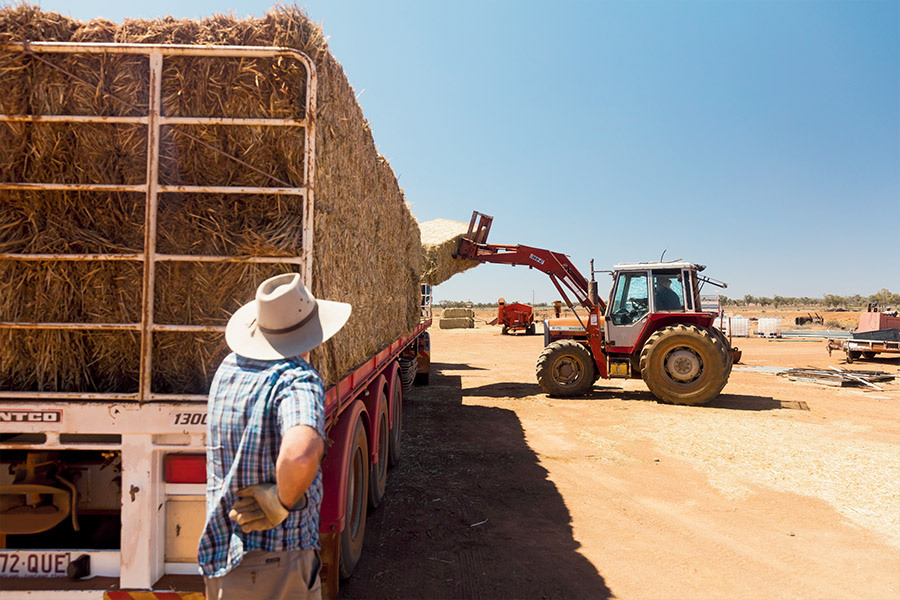 |
Typifying its likely workload, the demo unit was hooked to a tri-axle curtain-sided trailer and, like its 6×2 rigid sibling, the GK uses the direct-drive transmission.
Likewise, while the demo truck put power to the ground through a 3.7:1 final drive, 3.36 and 3.08 are the standard ratios. Weight ratings of the GK are 17 tonnes GVM and 45 tonnes GCM.
Top of the tree are the GW 26 420 and the flagship GW 26 460 models. Most notable of the very few differences between these two trucks are a GCM rating of 55 tonnes in the 420 version and 60 tonnes in the 460.
At this point, it’s worth noting that all models have standard fuel capacity of 400 litres and, depending on the model, either a 200- or 400-litre optional tank. AdBlue capacity in all Quons is 50 litres.
As for driving the trucks, there was obviously plenty to choose from, and our first stint was in the flagship GW 26 460 hooked to a curtain-sided B-double set loaded close to maximum weight.
It would, of course, be a tall order to put this model to work as a dedicated line-haul or even regional B-double outfit, especially at 60 tonnes.
Indeed, UD operatives were quick to counter any suggestion that long-distance B-double duties are a targeted application for the new Quon.
For that they’d not only need a 13-litre engine with 500-plus, but a cab with a considerably more spacious sleeper section. Right now, both are about as likely as Donald Trump cancelling his Twitter account.
Yet as the truck showed so capably on the short and relatively flat drive routes around Brisbane’s port and airport precincts, the 460 rating isn’t without the resolve to cope effectively with short-haul distribution work, even at 60 tonnes.
Nor is the sleeper completely inadequate for the occasional overnight stay.
That said, though, the truck’s capabilities as a short-haul B-double were, in our estimation, overshadowed by those combinations that more accurately reflect the likely workloads of UD’s new flagship.
For instance, as a tipper and three-axle dog combination or prime mover pulling a tri-axle trailer, the 460hp GW appeared to be totally in its element, delivering strong, responsive performance with levels of smooth, quiet ease that were nothing less than laudable.
Indeed, one of the advantages of a relatively small-displacement engine is lively throttle response, and the GH11 certainly demonstrated that quality at weights up to 50 tonnes.
Again, the compatibility of the engine and transmission combination across the range is exceptional, while ride, steering and road manners of all models in the demo group were top shelf.
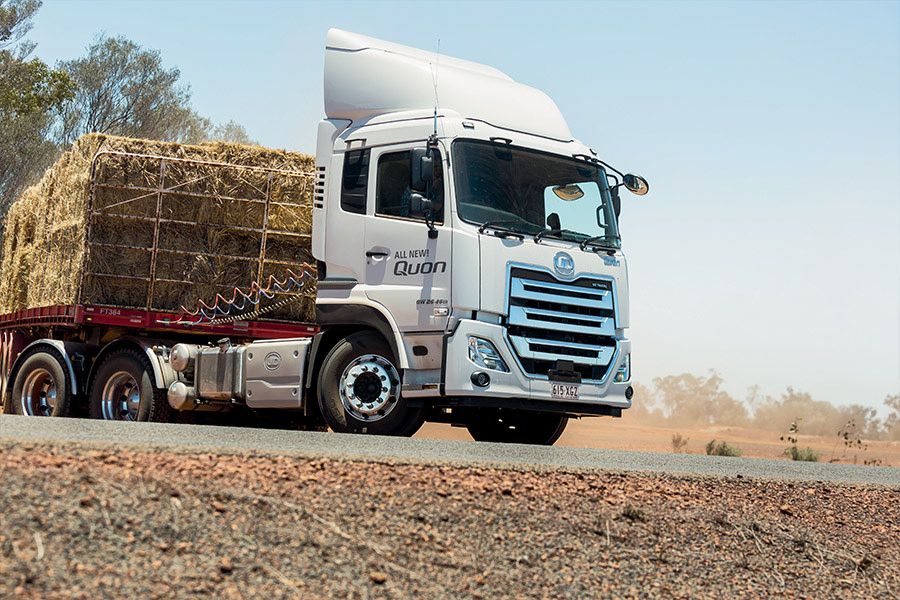 |
Importantly, access in and out of the cab and things like seat comfort, driving position, all-round vision, switchgear identification and placement all rate well.
One of few negatives, however, is the inconvenient siting of the mirror control switch on the left side of the dash behind the steering wheel.
Most brands mount mirror switches on the door, making it easy to adjust mirrors when reversing into tight spots. UD would do well to follow suit.
Meanwhile, switches for cruise control and the integral vehicle information system are ideally sighted on the arms of the steering wheel.
Best of all for us of an earlier generation, the function and logic of the information system are easily understood.
In short, it’s a cab layout that blends practicality with a commendable emphasis on comfort, function, and more than a hint of class thanks to some premium models sporting a smart two-tone leather-wrapped steering wheel and woodgrain inserts.
In our estimation, they’re a deserved touch for what is unquestionably a new standard among Japanese trucks in this class.
So, in a nutshell, the new Quon coped exceptionally well with the city and suburban vocations where the bulk of its business is sure to be done. Then again, not all trucks spend their life in the ’burbs, do they?
HOT TO TROT
Dwarfed by the big banger triples rolling through this part of the world, the UD seemed out of place heading out of Charleville towing two-high stacks of hay.
But a stockpile of hay stretches only so far and, as with all goods donated to Aussie Helpers, Brian Egan is determined to keep the distribution fair.
For us, that meant a couple of loads of square bales, which pushed gross weight to just 30 tonnes or thereabouts.
Still, arriving at the first property around midday with the mercury bubbling towards the mid-40s, the sight of a veteran UD rigid still earning its keep with a stock crate on the back was a quick reminder that life off the bitumen isn’t necessarily an issue for any brand when the fundamentals are sound.
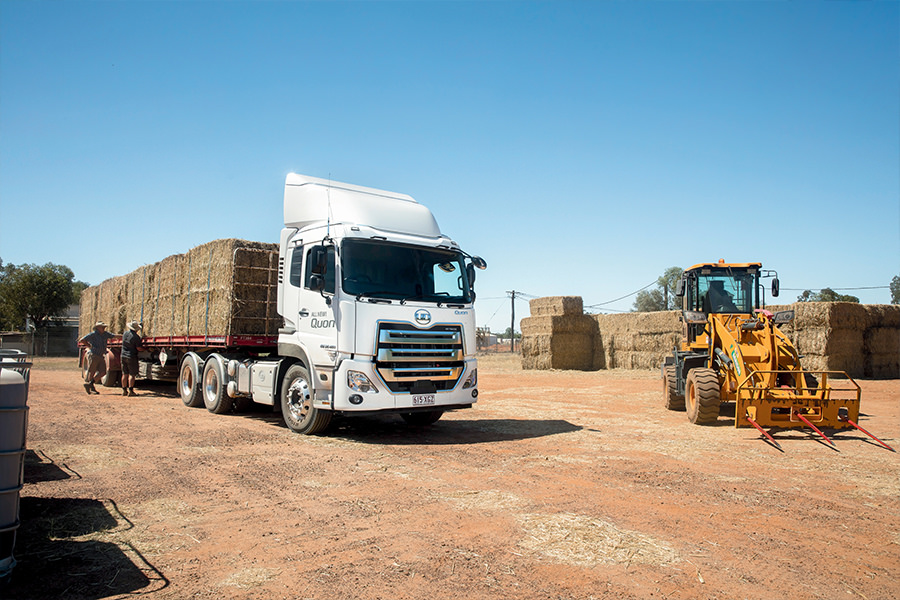 |
In fact, the first few hours on the run out of Charleville were already answering many of the questions about the new Quon’s aptitude for life beyond the ’burbs.
In this case, the GW 26 460 model was a pre-production unit with a tad more than 2000km on the clock and a few weeks earlier had been hooked to a curtain-sided tri-axle trailer as part of UD’s demo day.
Out here, though, things were vastly different and several factors were quickly apparent as the truck headed south towards Cunnamulla before turning west into hours of baked dirt, rutted creek beds and cooked rock.
For starters, the 4.5:1 diff ratio is essentially fine for stop-start suburban work but, at 100km/h with the engine pumping at 1800rpm, it’s far from ideal for fuel efficiency.
The 4.13:1 final drive would obviously be the better option for country and regional work.
Even so, early figures suggest fuel economy is an inherent quality of the GH11 engine.
After two days and almost 500km in the blistering heat of Queensland’s south-west, the truck’s trip computer reported an average consumption rate of 40 litres/100km (2.5km/litre, or 7.06mpg to us of an earlier era), while AdBlue was consumed at a miserly 1.9 litres/100km.
Likewise, while steering is effortlessly light for meandering through metro areas, it’s arguably a touch too sensitive at highway speeds. But then, at lower speeds on dirt roads, steering quality was fine.
All things considered, though, a slightly firmer steering box ratio would probably benefit Quon’s overall versatility.
Hard to believe, but day two came with a degree or two extra in the air and, westbound towards Quilpie, the country seemed even more withered.
Again, two-high stacks of hay certainly weren’t troubling the truck’s performance but the engine fan was being regularly called into service.
So regular, in fact, that road speed on the blacktop was pulled back to 90km/h to moderate both engine speed and fan use. It had the desired effect, with fan engagement time dropping markedly.
A definite and perhaps surprising contributor in keeping things cool was the Escot-Roll function.
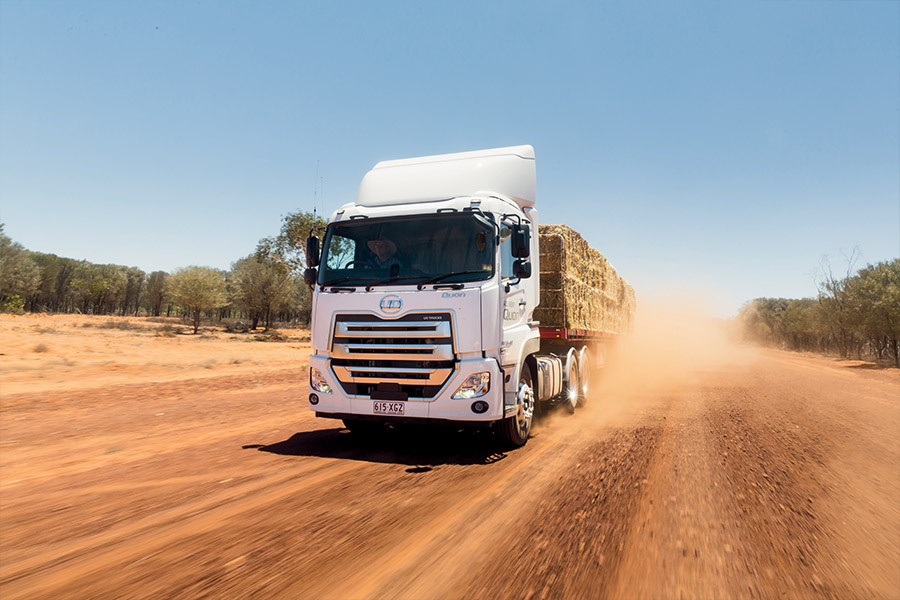 |
At this point, I have to admit to being something of a sceptic when it comes to the practical value of these eco-roll systems, particularly in the varied workloads of trucks essentially designed for city and suburban applications.
Out here, though, on long, open stretches of road, I saw the light and joined the converted. With the engine brake off, the transmission in ‘D’ at any gear above seventh, and foot off the throttle, the system quickly slips into neutral.
Then, on downhill stretches or running up to a turn, all it takes is a little confidence to let the system do its thing and it’s amazing how far the truck will roll under its own momentum.
Over time and distance, the positive effect on fuel economy must surely be considerable, while in this scorched environment, there was the added benefit of reduced fan engagement whenever Escot-Roll was in play.
Meanwhile, the build quality Japanese trucks are so highly regarded for is certainly evident in UD’s new flagship.
I must confess that, with this particular truck being a pre-production unit, there were initial thoughts that it would probably come with a few squeaks and squeals, rattles and bangs.
But no, the cab was as tight as a drum and, incidentally, the only dust finding its way inside was when a certain dopey driver opened a door too soon after pulling up on a dusty pad.
As for ride quality, the combined buffers of parabolic leaf springs at the front and an eight-bag rear suspension did a great job of softening the lumps and bumps, with or without a load.
Almost too good, perhaps, given the driver’s isolation from impacts at ground level. Still, I’ll take a soft, smooth ride over a bone-jarring back breaker anytime.
When it’s all boiled down, and in very simple terms, the latest Quon confirms UD has reached a point in its evolution that probably would not have been possible without the corporate connection to one of the trucking world’s biggest players.
No question, UD has always built a strong truck for its intended markets, but with the reliability of Japanese workmanship combining with the technical resources of Volvo, it is today a better truck than ever before.
As for the ‘poor cousin’ tag in the corporate threesome, forget it!
It won’t surprise if UD, over the next few years, achieves the greatest growth rate of all three brands in our neck of the Volvo kingdom. No surprise at all!


